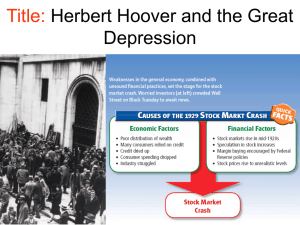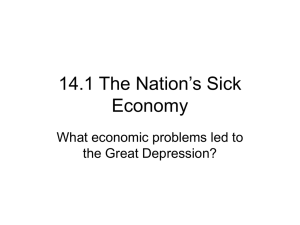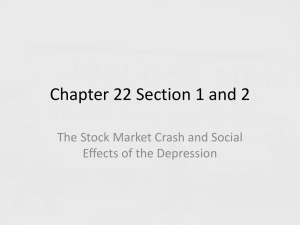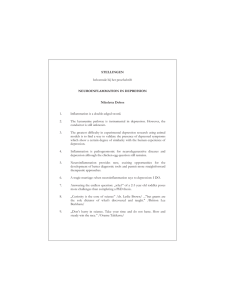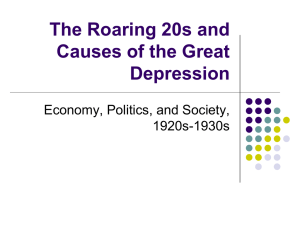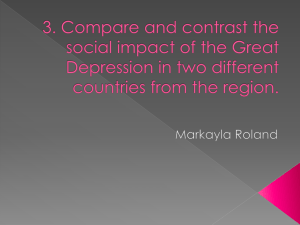PPT
advertisement
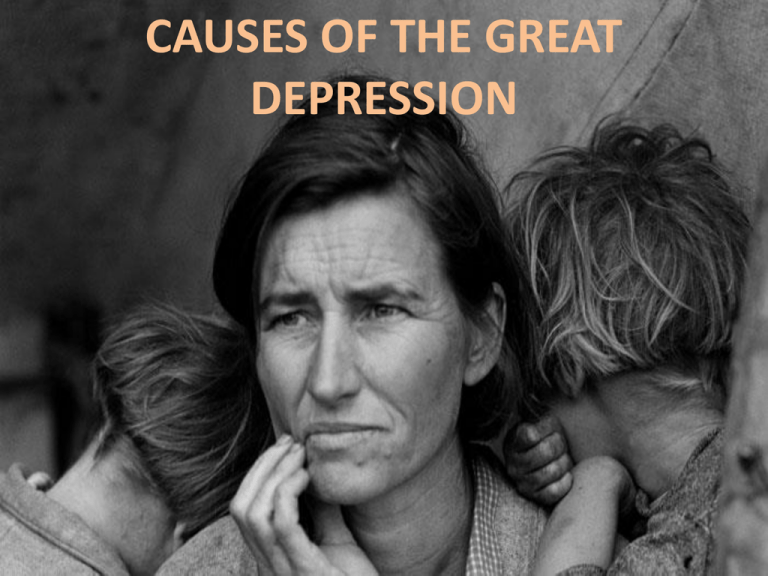
CAUSES OF THE GREAT DEPRESSION ■Essential Question: –What were the causes of the Great Depression? ■Warm-Up Question: –Think about the changes that took place in America in the 1920s. In what ways were these changes good? Bad? The Great Depression Era The Business of America Calvin Coolidge (President) fit pro-business spirit of the 1920s Famous quote: “The chief business of the American people is business . . .the man who builds a factory builds a temple – the man who works there worships there” American Business Flourishes President Coolidge (Republican) successor Herbert Hoover favored governmental policies that kept taxes down and business profits up Tariffs were high, which helped American manufacturers Government interference in business was minimal The Impact of the Auto Auto backbone of the American economy Ford Model T came only in black sold for $290 ($3553 in 2013 dollars) Over 15 million were sold by 1927 How Auto Changed America Paved roads, traffic lights, motels, billboards Home design (garages, driveways) Gas stations, repair shops, shopping centers Freedom for rural families Independence for women and young people By 1920 80% of world’s vehicles in U.S. American Standard Of Living Soars 1920-1929 (prosperity) Americans owned 40% of the world’s wealth average annual income rose 35% during the 1920s (for top earners) discretionary income increased Electrical Conveniences electricity transforms the nation Electric refrigerators Stoves Irons Toasters Vacuums washing machines sewing machines All available! Modern Advertising Emerges Ad agencies no longer sought to merely “inform” the public about their products Agencies hired psychologists to study how best to appeal to Americans‘desire for youthful, beauty, health and wealth “Say it with Flowers” slogan doubled sales between 1912-1924 A Superficial Prosperity Many during the 1920s believed the prosperity would go on forever Wages Production GNP stock market all rose significantly But. . . . Problems on the Horizon? Causes of the Great Depression The 1920s were a decade of consumer spending & the economy looked healthy on the surface: Income did increase in the 1920s, but there were some severe problems with the U.S. economy In October 1929, the “Roaring Twenties” came to an end & the Great Depression began…why? The Great Depression “We in America today are nearer to the final triumph over poverty than ever before in the history of any land. The poorhouse is vanishing from among us.” -- Herbert Hoover, 1928 Group Activity: What caused the Great Depression? In teams, determine what factors contributed to the Great Depression: Examine the documents provided & complete the chart in your notes After examining all documents, try to group the documents into categories When finished, create a one sentence thesis that explains why the depression began…be prepared to discuss Causes of the Great Depression Causes of the Great Depression Agricultural overproduction bank issue Industrial overproduction Uneven division of wealth Over-extension of credit bank issue International economic situation bank issue ■ Banking catastrophe 3 strikes against the banks Causes of the Depression Agricultural overproduction: – The end of WWI led to a decline in demand for agricultural products – Too much food led to a 40% drop in crop prices – Farmers could not pay back loans & many had their farms foreclosed – Some rural banks failed Causes of the Depression ◼ Industrial overproduction: –Mass-production of consumer goods led to overproduction –People did not need as many appliances & cars by the end of the decade (under-consumption) –Railroads, textiles, steel, coal mining, construction were barely profitable Overproduction of Consumer Goods Too much inventory…Not enough buyers “Traditional” industries suffered in the 1920s Corporate Profits for Coal and Railroad Industries, 1920-1930 Profits for Railroad Companies Profits for Coal Mining Causes of the Depression ◼ Uneven Division of Wealth –Despite rising wages, the gap between the rich & poor grew wider in the 1920s –70% of Americans were considered “poor” –Most of the spending in the 1920s was done by 30% of the population Distribution of Wealth in the 1920s * An income of $2,500 per year was considered the minimum amount needed for a decent standard of living Causes of the Depression ◼ Credit: – Many Americans used easy credit to live beyond their means – By “buying now & paying later,” Americans generated large debts – As a result, Americans cut back on spending by the end of the decade Americans bought goods on credit & did not have much in savings accounts Easy credit created a stock market bubble Causes of the Depression ◼ The Stock Market: –In the 1920s, the stock market soared & people speculated with stocks • bull market – upward trend in stock market –Many people borrowed money to pay for stocks, called buying on margin Buying Stocks on Margin Causes of the Depression ◼ The Stock Market: –There was no regulation of the market & some companies altered stock values to raise profits • bear market – downward trend in stock market Causes of the Depression ◼ The Stock Market: –On October 29, 1929 (Black Tuesday) the stock market crashed The stock market crash –People rushed sell, in October 1929 to marked the beginning of the& prices plummeted, “Great Depression” investors lost $30 billion –Speculators who bought on the margin, could not pay off their debts –Many lost their savings Causes of the Depression ■ The Stock Market: – Speculators who bought on the margin, could not pay off their debts – Many lost their savings “Wall Street Lays An Egg” - Daily Variety (Oct. 30, 1929) The U.S. stock market had only about 3 million active buyers & sellers but the spillover into the greater economy led to the Great Depression Causes of the Depression ◼ International Economic Situation: – France / England borrowed $$$ to finance WWI – Reparations from Germany / Austria used to make payments – Overtime, G and A could not make the reparation payments – 1927 – 1928 F and E borrowed more $ to pay debts Causes of the Depression ◼ International Economic Situation: – Post-war debts in Europe & high protective tariffs in America limited international trade – The Great Depression led to a global depression in Europe, Asia, & Latin America – World trade fell by 40% • exacerbated banking crisis A Global Depression Causes of the Depression ◼ Bank Failures: –After the crash, people tried to withdraw their money from banks –In 1929, 600 banks failed due to lack of funds & the inability to recoup loans –The failure of the banks left many Americans without their life savings Bank & Business Failures, 1928-1933 Effects of the Great Depression ■ The Great Depression led to a collapse of the U.S. financial system – 9,000 banks & 90,000 businesses failed by 1933 – Gross National Product (GNP) total value of all goods and services produced in a given year • 1929 -- GNP = $103 Billion • 1933 -- GNP = $56 Billion – 15% unemployment throughout the 30s, sometimes reaching as high as 25% Effects of the Great Depression ■ Consumer Confidence: – Millions of Americans lost their jobs or took pay cuts to keep jobs – The lack of confidence in the future kept people from spending money – The lack of spending made the depression drag on until the 1940s Unemployment & Consumer Spending, 19281933 Depression Life ■ Shantytowns or (“Hoovervilles”) – with no money for mortgages, many forced onto streets • selling an apple – America had record poverty & suicide rates; Fathers abandoned families; Healthcare declined Depression Life – Private charities created soup kitchens & breadlines to help • breadlines and soup kitchens synonymous with the Great Depression Soup Kitchens & Breadlines Mortgage Foreclosures Poverty in America The Dust Bowl ■ The effects of the depression were made worse by the Dust Bowl: –Heavy droughts & over-farming in the West destroyed the Plains –In the early 1930s, windstorms swept away loose soil –Farmers in the Plains left their farms & searched for work or better land in West coast states Dust Bowl Dust Bowl ■ Farmers in crisis – drought creates setting for (Harvest Gypsies – The Grapes of Wrath) The Dust Bowl (1931-1939) Areas Affected by the Dust Bowl drought “Okies” & “Arkies” worsened the effects of the Depression How Herbert Hoover Dealt with the Crisis ■ Confidence economics - “Prosperity is right around the corner.” ■ Rugged Individualism - Success comes through individual effort / private enterprise How Herbert Hoover Dealt with the Crisis “I do not believe that the power and duty of the General Government ought to be extended to the relief of individual suffering.... The lesson should be constantly enforced that though the people support the Government the Government should not support the people.” -- Herbert Hoover, 1930 How Herbert Hoover Dealt with the Crisis Who should relieve the suffering? Community / Church resources - Salvation Army, Community Chest, Red Cross President Hoover’s Response ■President Herbert Hoover initially rejected bold government action in response to the depression: –He tried to reassure Americans that prosperity would return –He called for volunteerism & “rugged individualism” President Hoover’s Response ■ As the depression worsened, Hoover called for more gov’t action –The gov’t issued relief checks to help the unemployed –The Reconstruction Finance Corps (RFC) loaned money to failing businesses –Building projects like Hoover Dam ■ These efforts did not end the depression & many citizens lost faith in President Hoover The Bonus Army 1932 ■ 15,000 WWI veterans marched to Washington D.C. to get a bonus ($) – they were supposed to receive the bonus in 1945 The Bonus Army 1932 ■ Hoover called the United States Army in to disperse the Bonus Marchers Conclusions ■ The Depression of the 1930s came as a shock to Americans: –When the stock market crashed in 1929, businesses closed & millions were unemployed –Americans lost faith in Hoover & began looking for new leadership & a more active government to solve their problems
